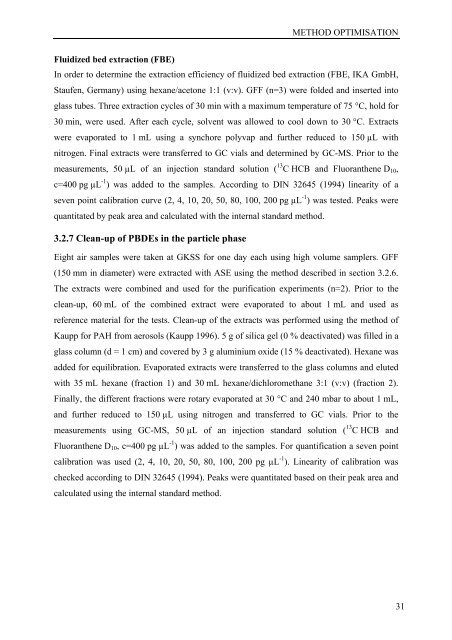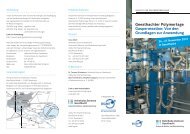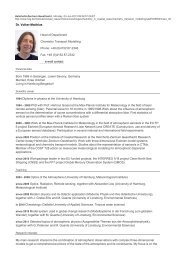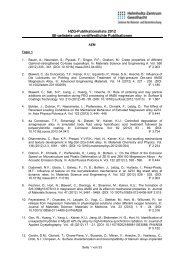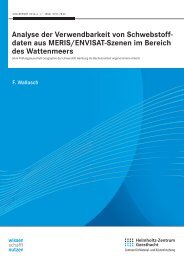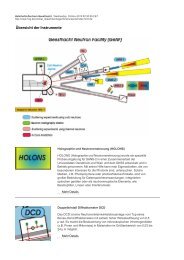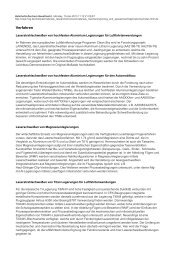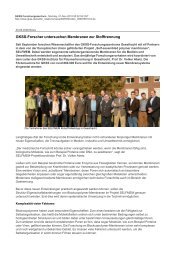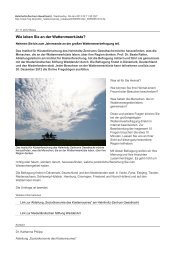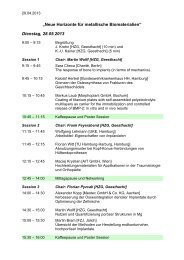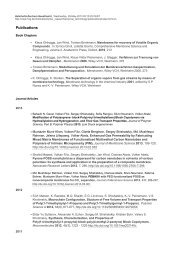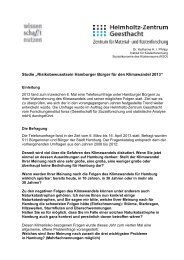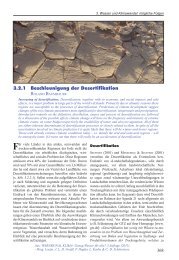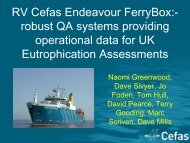Landfills and waste water treatment plants as sources of ... - GKSS
Landfills and waste water treatment plants as sources of ... - GKSS
Landfills and waste water treatment plants as sources of ... - GKSS
Create successful ePaper yourself
Turn your PDF publications into a flip-book with our unique Google optimized e-Paper software.
METHOD OPTIMISATION<br />
Fluidized bed extraction (FBE)<br />
In order to determine the extraction efficiency <strong>of</strong> fluidized bed extraction (FBE, IKA GmbH,<br />
Staufen, Germany) using hexane/acetone 1:1 (v:v). GFF (n=3) were folded <strong>and</strong> inserted into<br />
gl<strong>as</strong>s tubes. Three extraction cycles <strong>of</strong> 30 min with a maximum temperature <strong>of</strong> 75 °C, hold for<br />
30 min, were used. After each cycle, solvent w<strong>as</strong> allowed to cool down to 30 °C. Extracts<br />
were evaporated to 1 mL using a synchore polyvap <strong>and</strong> further reduced to 150 μL with<br />
nitrogen. Final extracts were transferred to GC vials <strong>and</strong> determined by GC-MS. Prior to the<br />
me<strong>as</strong>urements, 50 μL <strong>of</strong> an injection st<strong>and</strong>ard solution ( 13 C HCB <strong>and</strong> Fluoranthene D10,<br />
c=400 pg μL -1 ) w<strong>as</strong> added to the samples. According to DIN 32645 (1994) linearity <strong>of</strong> a<br />
seven point calibration curve (2, 4, 10, 20, 50, 80, 100, 200 pg μL -1 ) w<strong>as</strong> tested. Peaks were<br />
quantitated by peak area <strong>and</strong> calculated with the internal st<strong>and</strong>ard method.<br />
3.2.7 Clean-up <strong>of</strong> PBDEs in the particle ph<strong>as</strong>e<br />
Eight air samples were taken at <strong>GKSS</strong> for one day each using high volume samplers. GFF<br />
(150 mm in diameter) were extracted with ASE using the method described in section 3.2.6.<br />
The extracts were combined <strong>and</strong> used for the purification experiments (n=2). Prior to the<br />
clean-up, 60 mL <strong>of</strong> the combined extract were evaporated to about 1 mL <strong>and</strong> used <strong>as</strong><br />
reference material for the tests. Clean-up <strong>of</strong> the extracts w<strong>as</strong> performed using the method <strong>of</strong><br />
Kaupp for PAH from aerosols (Kaupp 1996). 5 g <strong>of</strong> silica gel (0 % deactivated) w<strong>as</strong> filled in a<br />
gl<strong>as</strong>s column (d = 1 cm) <strong>and</strong> covered by 3 g aluminium oxide (15 % deactivated). Hexane w<strong>as</strong><br />
added for equilibration. Evaporated extracts were transferred to the gl<strong>as</strong>s columns <strong>and</strong> eluted<br />
with 35 mL hexane (fraction 1) <strong>and</strong> 30 mL hexane/dichloromethane 3:1 (v:v) (fraction 2).<br />
Finally, the different fractions were rotary evaporated at 30 °C <strong>and</strong> 240 mbar to about 1 mL,<br />
<strong>and</strong> further reduced to 150 μL using nitrogen <strong>and</strong> transferred to GC vials. Prior to the<br />
me<strong>as</strong>urements using GC-MS, 50 μL <strong>of</strong> an injection st<strong>and</strong>ard solution ( 13 C HCB <strong>and</strong><br />
Fluoranthene D10, c=400 pg μL -1 ) w<strong>as</strong> added to the samples. For quantification a seven point<br />
calibration w<strong>as</strong> used (2, 4, 10, 20, 50, 80, 100, 200 pg μL -1 ). Linearity <strong>of</strong> calibration w<strong>as</strong><br />
checked according to DIN 32645 (1994). Peaks were quantitated b<strong>as</strong>ed on their peak area <strong>and</strong><br />
calculated using the internal st<strong>and</strong>ard method.<br />
31


